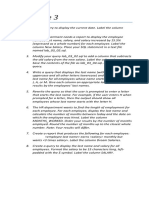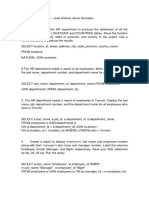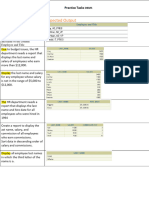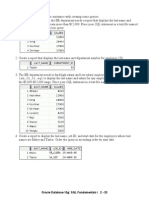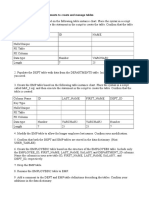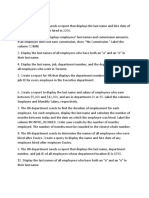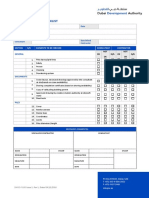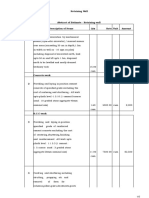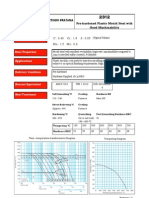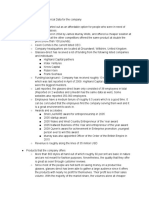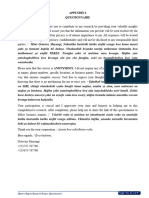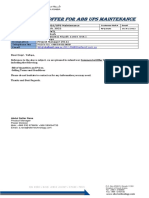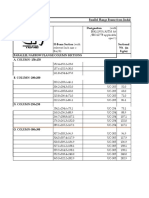Practice 2: Overview
In this practice, you build more reports, including statements that use the WHERE clause and
the ORDER BY clause. You make the SQL statements more reusable and generic by including
the ampersand substitution.
Practice 2
The HR department needs your assistance in creating some queries.
1. Because of budget issues, the HR department needs a report that displays the last
name and salary of employees who earn more than $12,000. Save your SQL statement as a
file named lab_02_01.sql. Run your query.
2. Open a new SQL Worksheet. Create a report that displays the last name and
department number for employee number 176. Run the query.
3. The HR department needs to find high-salary and low-salary employees. Modify
lab_02_01.sql to display the last name and salary for any employee whose salary is not in
the range of $5,000 to $12,000. Save your SQL statement as lab_02_03.sql.
4. Create a report to display the last name, job ID, and start date for the employees
with the last names of Matos and Taylor. Order the query in ascending order by the start
date.
5. Display the last name and department number of all employees in departments 20 or
50 in ascending alphabetical order by name.
6. Modify lab_02_03.sql to display the last name and salary of employees who earn
between $5,000 and $12,000, and are in department 20 or 50. Label the columns Employee
and Monthly Salary, respectively. Resave lab_02_03.sql as lab_02_06.sql. Run the statement
in lab_02_06.sql.
7. The HR department needs a report that displays the last name and hire date for all
employees who were hired in 1994.
8. Create a report to display the last name and job title of all employees who do not
have a manager.
9. Create a report to display the last name, salary, and commission of all employees
who earn commissions. Sort data in descending order of salary and commissions.
Use the column’s numeric position in the ORDER BY clause.
10. Members of the HR department want to have more flexibility with the queries that
you are writing. They would like a report that displays the last name and salary of employees
who earn more than an amount that the user specifies after a prompt. Save this query to a
file named lab_02_10.sql. If you enter 12000 when prompted, the report displays the
following results:
�11. The HR department wants to run reports based on a manager. Create a query that
prompts the user for a manager ID and generates the employee ID, last name, salary, and
department for that manager’s employees. The HR department wants the ability to sort the
report on a selected column. You can test the data with the following values:
manager_id = 103, sorted by last_name:
manager_id = 201, sorted by salary:
manager_id = 124, sorted by employee_id:
12. Display all employee last names in which the third letter of the name is “a.”
13. Display the last names of all employees who have both an “a” and an “e” in their last
name.
14. Display the last name, job, and salary for all employees whose jobs are either those
of a sales representative or of a stock clerk, and whose salaries are not equal to $2,500,
$3,500, or $7,000.
15. Modify lab_02_06.sql to display the last name, salary, and commission for all
employees whose commission is 20%. Resave lab_02_06.sql as lab_02_15.sql. Rerun the
statement in lab_02_15.sql.




















